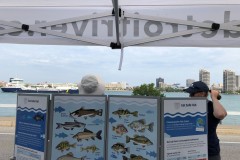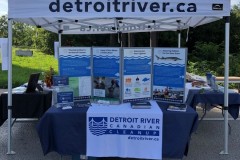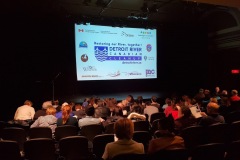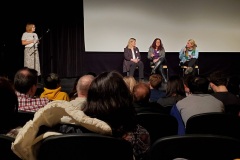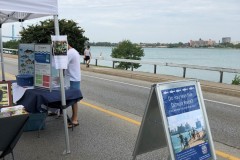Each year, the DRCC works with community partners and members on a wide range of education opportunities relating to the Detroit River. For more information on previous projects, please visit our Annual Review (yearly reports) and DRCC Publications pages.
9th Annual Detroit River Evening
Many thanks to everyone who came out for the Detroit River Evening on June 17th, 2020 on Zoom. There were over 150 people who either attended or watched the video since the event! Thanks to all the presenters who provided updates on the important work being done in the Detroit River Area of Concern by the DRCC Public Advisory Council, Environment and Climate Change Canada, and Fisheries and Oceans Canada.
Miss the event? Watch it on our YouTube here:
Screening of ECOHIGHWAY 2021
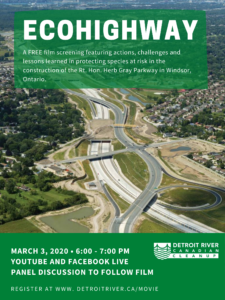 The DRCC hosted a virtual film screening of Ecohighway, in partnership with the Essex Region Conservation Authority, Ontario Ministry of Environment, Conservation, and Parks, and Environment and Climate Change Canada.
The DRCC hosted a virtual film screening of Ecohighway, in partnership with the Essex Region Conservation Authority, Ontario Ministry of Environment, Conservation, and Parks, and Environment and Climate Change Canada.
Ecohighway is a film about actions, challenges, and lessons learned in protecting species at risk in the construction of the Rt. Hon. Herb Gray Parkway in Windsor, Ontario. There are more than 500 plant and animal species at risk in Canada. In the Essex region, more than 240 federally or provincially rare species of plants or animals have been recorded, making the Essex Region one of the most diverse regions in the country for species at risk. The film highlights efforts made to ensure that species at risk were protected or relocated to reduce the environmental impacts of the Parkway infrastructure project.
“The Parkway project took reducing the impacts of construction on species at risk very seriously and was quite successful in ensuring species at risk protection. The project and its approach to managing species at risk should be an example for future infrastructure projects,” said Jacqueline Serran, the Remedial Action Plan Coordinator for the Detroit River Canadian Cleanup. “By incorporating species at risk protection and prairie restoration in the construction of the Parkway project, a natural corridor within the Detroit River watershed was created that plants, animals, and humans can use and enjoy.”
Following the film, audience members heard from a panel of experts who were actively involved in the protection and relocation of species at risk during the Parkway project, including Dan Lebedyk, Biologist/Ecologist from the Essex Region Conservation Authority, Russ Jones, lead field biologist on the Parkway project, and Dr. Season Snyder, Senior Plant Ecologist with Wood Environment and Infrastructure.
View the recording of the film screening :
Detroit River Restoration Projects Highlighted
The DRCC attended the Great Lakes Restoration Celebration, hosted by the Alliance of Rouge Communities and held at The Henry Ford in Dearborn on October 18, 2019. As part of this celebration, a book was created showcasing the organizations contributing to Great Lakes Restoration in Southeast Michigan and some of their restoration projects.
The DRCC and our projects are featured in the book, and a copy can be downloaded from here.
US Sediment Remediation Update
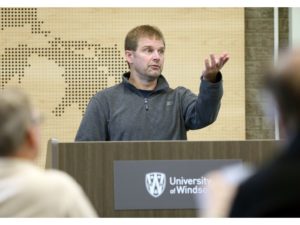
(NICK BRANCACCIO/Windsor Star)
The DRCC Public Advisory Council hosted US colleagues who provided a presentation on the progress of sediment remediation efforts on the American side of the Detroit River. The presentation highlighted the projects American partners are tackling to improve sediment quality, which improves overall ecosystem health of the river system.
In 2012, a comprehensive study took place by multiple partners where data was compiled about known contaminants at 65 locations in the Detroit River. The study characterized sediment on the US side of the river, including the quantity of contaminants at these sites. This project provided a basis for the US Environmental Protection Agency and the Michigan Department of Environment, Great Lakes and Energy to create a prioritized list of sediment remediation projects.
The estimated total quantity of sediment that needs to be remediated from the U.S side of the Detroit River is approximately 6,673,338yd3. Generally where sediments were present in the nearshore, they were contaminated, and contaminants were highest near historical industrial and municipal outfalls. Some of the remediation work has begun and progress is being made, but partners and funding opportunities need to be identified for large scale remediation to occur. Thanks again to our US counterparts for this presentation outlining the progress they’ve been making on the US side of the river! Find out more in this news article from Great Lakes Now.
Cleanup Events and Community Tree Plantings
The DRCC supports community cleanups and tree planting activities through our member organizations. Not only do these activities improve habitat quality for plants and animals, they also enhance the quality of life for local residents.
Through events held in the fall of 2019 and spring of 2020, approximately 2,800 native trees and shrubs were planted with the help of 1,460 fantastic volunteers and 10 community partners. Additionally, more than 1,300 people and over 50 Green Teams attended the annual Earth Day celebrations in the Little River watershed and planted more than 2,200 trees!
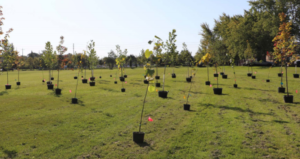
Ensuring Long Term Growth and Survival at Community Restoration Sites
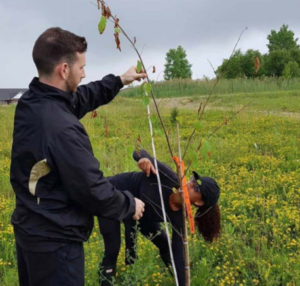 In preparation for the large Earth Day community planting, members of the How to Crew received in-depth tree planting and care training to assist with implementing the planting plan at the spring celebration. The How to Crew assists ERCA by providing quality control measures during community planting events to ensure the long term growth and survival of the trees. They are on hand to help volunteers troubleshoot planting seedlings, balled and burlap evergreens, and potted hardwoods as well as checking proper planting techniques, mulching, tree guards and more.
In preparation for the large Earth Day community planting, members of the How to Crew received in-depth tree planting and care training to assist with implementing the planting plan at the spring celebration. The How to Crew assists ERCA by providing quality control measures during community planting events to ensure the long term growth and survival of the trees. They are on hand to help volunteers troubleshoot planting seedlings, balled and burlap evergreens, and potted hardwoods as well as checking proper planting techniques, mulching, tree guards and more.
Following the community planting, during National Forest Week in September 2019, the DRCC and ERCA hosted a citizen science survey workshop to collect tree health and growth data from a sample of the Earth Day trees planted in the spring. This information is helpful in understanding how well the trees are growing and what adjustments could be made to further ensure long term growth and survival at community restoration sites.
Detroit River Family Fishing Day, 2018
In partnership with the Town of LaSalle, University of Windsor, Essex Region Conservation and Just Fishin’ Friends, the Detroit River Canadian Cleanup hosted our second annual Learn to Fish event on July 7th at Front Road Park in LaSalle. Over 150 participants came to fish (some for the first time!) and learn from expert volunteer anglers with the use of free equipment and bait. And the fish were biting!
Researchers gave tours of the University of Windsor Freshwater Restoration Ecology Centre and the Ontario Clean Water Agency and Ontario Federation of Anglers and Hunters were also on hand with great educational displays. Big thanks to everyone who joined us and to all our volunteers.
Wastewater, Where does it go?
Have you ever wondered what happens to water and other substances when they are flushed down our drains and toilets? It shouldn’t be a mystery, and the City of Windsor and the Detroit River Canadian Cleanup initiative have partnered to create a wastewater video to help de-mystify the topic, and educate viewers.
Everything we put down our drains can have a big impact on our home and our environment. For example, there are many household items that are branded as ‘flushable’ that shouldn’t be put down the toilet. Same goes with old, expired medication — wastewater treatment plants were never designed to remove those substances from water.
The video follows the flow of wastewater from a home in Windsor to one of two places: the wastewater treatment plant or the Detroit River. Using stunning graphics, the video highlights where the water goes, tips on what you should and shouldn’t put down the drain, and how our wastewater gets treated before being released into the Detroit River.
Number one, number two and TP…toilet paper — is the video’s final reminder, and the message the partners hope that viewers retain. View the video by clicking ‘Play’ below:

